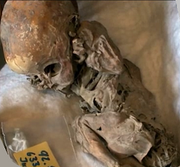Forty-two Himalayan mummies including three children under the age of six were found during an expedition led by archaeologist Mark Aldenderfer in the caves of Nepal's Upper Mustang region in the 1990s. The bones collected are thought to be the mysterious Membrak people, and were, pieced together, and analyzed.
Mummification[]
Due to the environment they were buried in the arid condition of the mountainous region and the caves that protected them.
Studies[]
The age of the burials ran about 450 years.
Pathology[]
There is evidence of successful surgical treatment, implying considerable medical knowledge. The general state of health shows the individuals to have been well adapted to their extreme environment on the edge of human habitation.
Additional[]
Two of the bodies seem to have been of a mother and an infant dating to about 450 BC, recovered in a sleeping posture where the woman seems to have protected her infant in every possible way.

The body of the infant was found all compact, with steady bones and joints that were not detached. Even a layer of thin skin covering the infant’s bones is still intact. Some parts of the woman's body including limbs were also intact. The discovery was made during an excavation between 1992-1997. The woman seemed to be holding the child tightly, her posture played a role in protecting the infant’s body from decomposing, say experts.
External Links[]
https://www.nationalgeographic.org/media/analyzing-himalayan-mummies/
